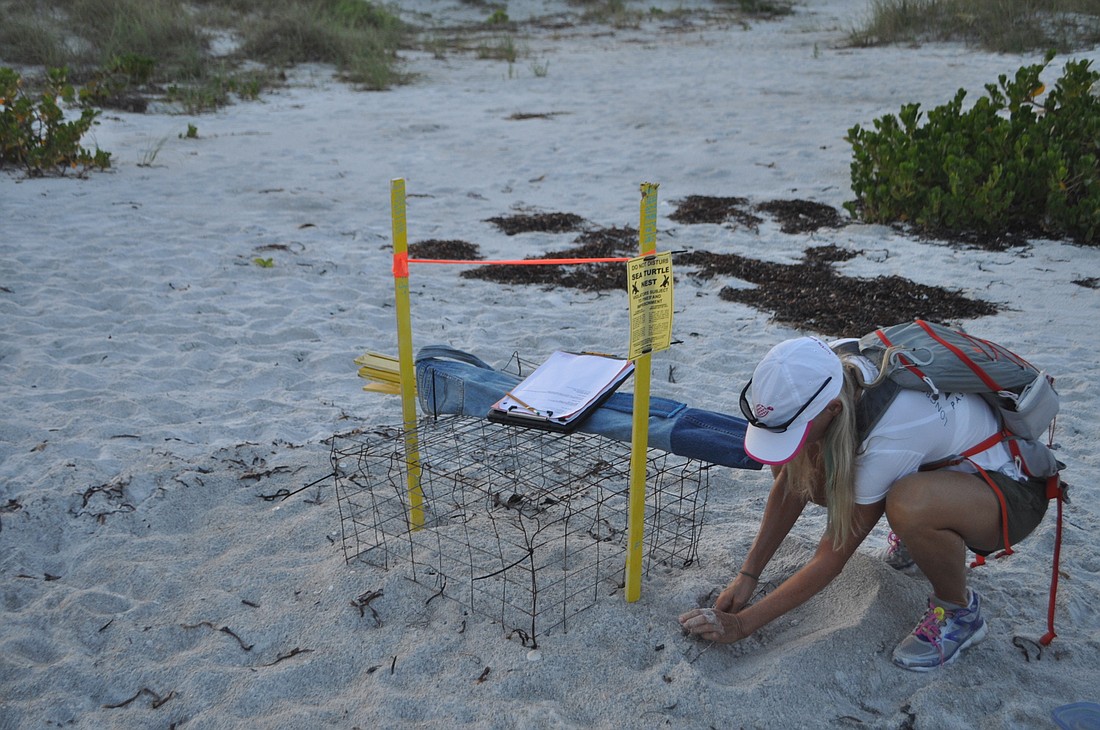- December 22, 2024
-
-
Loading

Loading

On Cyndi Seamon’s first beach patrol of nesting season, she found a yellow smiley-face balloon close to the shoreline.
The brightly colored, inflated balloon looked innocent enough, but it could have caused a lot of problems for a mother turtle trying to nest. Seamon disposed of the balloon before a turtle or other animal found it first.
The discovery, and Seamon’s reaction, spotlights the delicate balance that exists between animals and people during the next six months.
Until Oct. 31, Seamon and the 70 other Longboat Key Turtle Watch volunteers will monitor the Key’s Manatee County beaches, checking for newly laid nests and picking up trash, such as the balloon, that might hinder nesting, and later, hatching sea turtles. For many of them, their mornings begin at 6 a.m.
“Just selfishly getting up in the morning and being the first one on the beach gives me the initiative to get up and get out there and share it with those other people that I’ve gotten to meet that I wouldn’t have met otherwise,” Seamon said.
When the trained volunteers find turtle tracks, they follow them and gently tiptoe around the area where they suspect eggs are buried. They dig a little into the sand until they see an egg, then cover it back up and mark the area with wooden stakes.
From fundraising to community outreach and education, the Longboat Key Turtle Watch has brought turtles to the forefront of Longboat residents’ and visitors’ minds since 1969. The group started monitoring beaches in 1970.
Seamon, vice president of the group, started monitoring beaches in 2003. For her, joining the group allowed her to form strong friendships with people she isn’t sure she would have met otherwise. Many Turtle Watch volunteers have like-minded interests, starting with turtles, and can spread those interests to others, Seamon said.
“This is a great place to come visit, and a lot of people have no idea that we have sea turtles nesting on our shores,” she said.
Since its inception, Turtle Watch has been instrumental in getting laws passed requiring fishing nets to include so-called turtle excluder devices and helped get laws passed to ban fires on beaches.
More recently, the group helped a new town ordinance pass that makes it a violation to leave furniture and other recreational items near the shoreline at night, among other guidelines.
But perhaps one of the largest pieces of history for Turtle Watch came when it merged with Mote Marine Laboratory in 2005. Mote, which monitors Sarasota County beaches, holds a nesting survey permit that allows the Longboat Key Turtle Watch to patrol beaches, take data and excavate nests. Prior to the partnership, Turtle Watch had its own permit. When Turtle Watch volunteers find or excavate a nest, they provide Mote with all the necessary data.
“We work very closely, and they definitely serve a wonderful purpose on Longboat Key because they do a lot of outreach things that we don’t have the time for,” said Kristen Mazzarella, senior biologist for sea turtle conservation and research at Mote.
Beyond marking and excavating nests along the beach, Turtle Watch leaves tracks around Longboat Key.
The group plans to help the town distribute pamphlets on Longboat’s new turtle-protection rules. Organizers also attended the Longboat Key Community Open House in March with interactive displays that taught people about turtle and beach safety. A lighting display is set up in Town Hall, so people know what lights will harm turtles.
But for all the hours invested in outreach and education, there’s still nothing quite like watching wobbly hatchlings make their way to the Gulf of Mexico.
“There’s that first crawl, and even in the middle of summer when there’s five [excavations], it’s still exciting to see,” Seamon said.